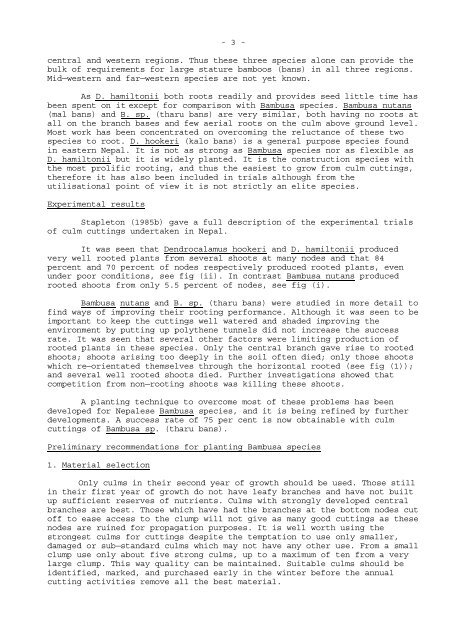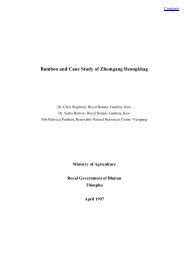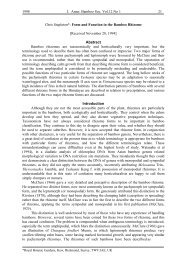Propagation of Bambusa & Dendrocalamus species by culm cuttings
Propagation of Bambusa & Dendrocalamus species by culm cuttings
Propagation of Bambusa & Dendrocalamus species by culm cuttings
You also want an ePaper? Increase the reach of your titles
YUMPU automatically turns print PDFs into web optimized ePapers that Google loves.
- 3 -<br />
central and western regions. Thus these three <strong>species</strong> alone can provide the<br />
bulk <strong>of</strong> requirements for large stature bamboos (bans) in all three regions.<br />
Mid—western and far—western <strong>species</strong> are not yet known.<br />
As D. hamiltonii both roots readily and provides seed little time has<br />
been spent on it except for comparison with <strong>Bambusa</strong> <strong>species</strong>. <strong>Bambusa</strong> nutans<br />
(mal bans) and B. sp. (tharu bans) are very similar, both having no roots at<br />
all on the branch bases and few aerial roots on the <strong>culm</strong> above ground level.<br />
Most work has been concentrated on overcoming the reluctance <strong>of</strong> these two<br />
<strong>species</strong> to root. D. hookeri (kalo bans) is a general purpose <strong>species</strong> found<br />
in eastern Nepal. It is not as strong as <strong>Bambusa</strong> <strong>species</strong> nor as flexible as<br />
D. hamiltonii but it is widely planted. It is the construction <strong>species</strong> with<br />
the most prolific rooting, and thus the easiest to grow from <strong>culm</strong> <strong>cuttings</strong>,<br />
therefore it has also been included in trials although from the<br />
utilisational point <strong>of</strong> view it is not strictly an elite <strong>species</strong>.<br />
Experimental results<br />
Stapleton (1985b) gave a full description <strong>of</strong> the experimental trials<br />
<strong>of</strong> <strong>culm</strong> <strong>cuttings</strong> undertaken in Nepal.<br />
It was seen that <strong>Dendrocalamus</strong> hookeri and D. hamiltonii produced<br />
very well rooted plants from several shoots at many nodes and that 84<br />
percent and 70 percent <strong>of</strong> nodes respectively produced rooted plants, even<br />
under poor conditions, see fig (ii). In contrast <strong>Bambusa</strong> nutans produced<br />
rooted shoots from only 5.5 percent <strong>of</strong> nodes, see fig (i).<br />
<strong>Bambusa</strong> nutans and B. sp. (tharu bans) were studied in more detail to<br />
find ways <strong>of</strong> improving their rooting performance. Although it was seen to be<br />
important to keep the <strong>cuttings</strong> well watered and shaded improving the<br />
environment <strong>by</strong> putting up polythene tunnels did not increase the success<br />
rate. It was seen that several other factors were limiting production <strong>of</strong><br />
rooted plants in these <strong>species</strong>. Only the central branch gave rise to rooted<br />
shoots; shoots arising too deeply in the soil <strong>of</strong>ten died; only those shoots<br />
which re—orientated themselves through the horizontal rooted (see fig (1));<br />
and several well rooted shoots died. Further investigations showed that<br />
competition from non—rooting shoots was killing these shoots.<br />
A planting technique to overcome most <strong>of</strong> these problems has been<br />
developed for Nepalese <strong>Bambusa</strong> <strong>species</strong>, and it is being refined <strong>by</strong> further<br />
developments. A success rate <strong>of</strong> 75 per cent is now obtainable with <strong>culm</strong><br />
<strong>cuttings</strong> <strong>of</strong> <strong>Bambusa</strong> sp. (tharu bans).<br />
Preliminary recommendations for planting <strong>Bambusa</strong> <strong>species</strong><br />
1. Material selection<br />
Only <strong>culm</strong>s in their second year <strong>of</strong> growth should be used. Those still<br />
in their first year <strong>of</strong> growth do not have leafy branches and have not built<br />
up sufficient reserves <strong>of</strong> nutrients. Culms with strongly developed central<br />
branches are best. Those which have had the branches at the bottom nodes cut<br />
<strong>of</strong>f to ease access to the clump will not give as many good <strong>cuttings</strong> as these<br />
nodes are ruined for propagation purposes. It is well worth using the<br />
strongest <strong>culm</strong>s for <strong>cuttings</strong> despite the temptation to use only smaller,<br />
damaged or sub—standard <strong>culm</strong>s which may not have any other use. From a small<br />
clump use only about five strong <strong>culm</strong>s, up to a maximum <strong>of</strong> ten from a very<br />
large clump. This way quality can be maintained. Suitable <strong>culm</strong>s should be<br />
identified, marked, and purchased early in the winter before the annual<br />
cutting activities remove all the best material.





